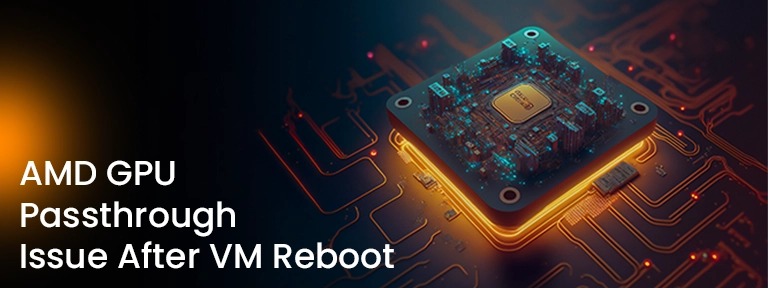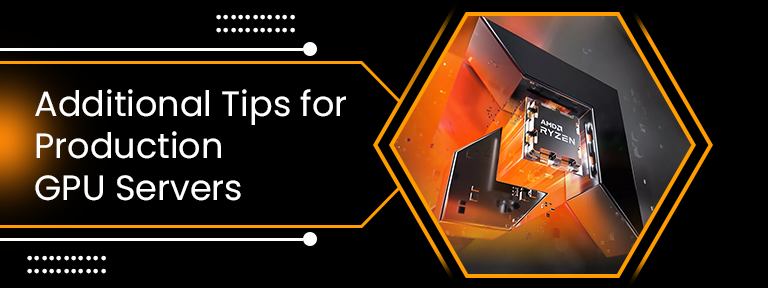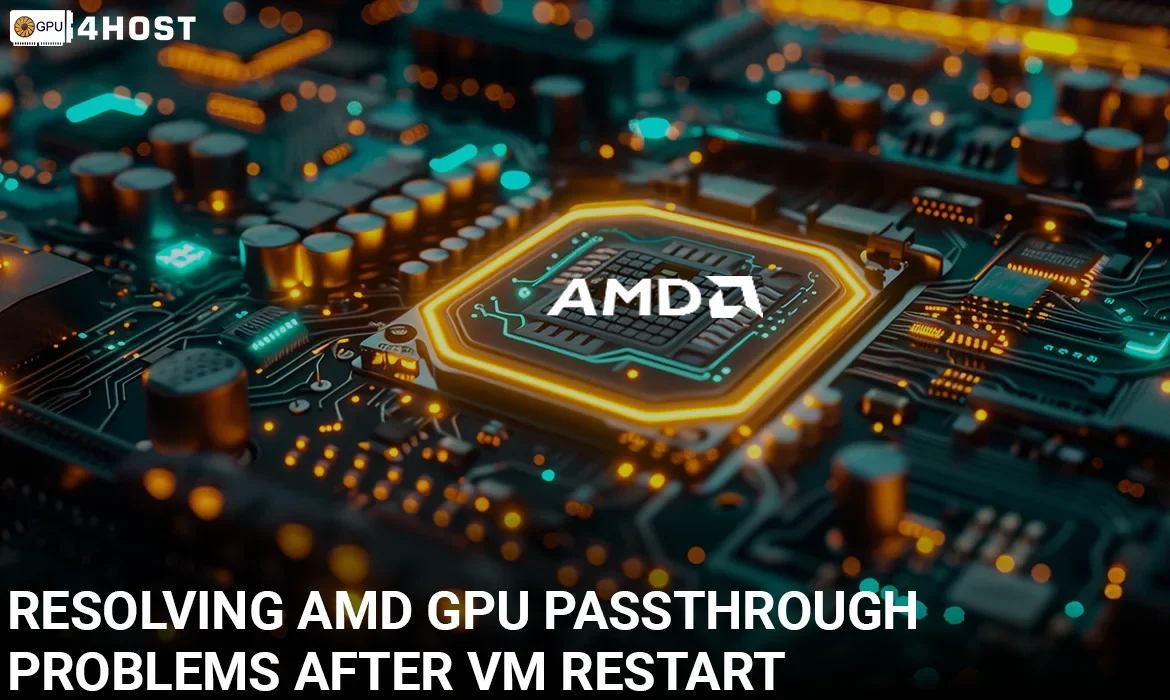AMD GPU passthrough issue
Resolving AMD GPU Passthrough Problems After VM Restart
Setting up a GPU server with NVIDIA or AMD graphics in a virtualized setting can significantly boost performance for artificial intelligence, machine learning, and high-quality rendering workloads. However, all those users using AMD GPU passthrough in virtual machines (VMs) generally face a frustrating challenge: after restarting the VM, the GPU driver either fails to load or the system doesn’t identify the GPU at all.
If you have also experienced this, don’t worry; you are not alone. This guide offers a comprehensive solution to fix the AMD GPU passthrough issue after a VM restart—making sure that your GPU dedicated server remains dedicated to delivering high performance.
Whether you’re utilizing GPU4HOST, handling GPU hosting environments, or running complex GPU clusters for AI-based tasks, this article takes you through a practical, user-friendly fix.
Knowing About the AMD GPU Passthrough Issue
The AMD GPU passthrough issue mainly happens in virtualized environments such as Proxmox or KVM/QEMU when a VM is set up to utilize a dedicated AMD GPU. After restarting the VM:
- The AMD driver may not initialize correctly.
- The VM might sometimes hang or crash at the time of boot.
- You may get to see a black screen or no video result.
- lspci shows the GPU, but the operating system fails to bind the driver.
This issue is very common with AMD Radeon GPUs passed through to both Windows and Linux VMs, which are using VFIO (Virtual Function I/O). Apart from NVIDIA GPU passthrough, AMD GPUs can behave completely differently just because of reset bugs and driver traits.
Why Does the AMD GPU Passthrough Issue Happen?
- GPU Restart Bug: Various AMD cards, mainly consumer-level ones, have a shortage of a proper hardware reset operation. Once started by the host or virtual machine, they may not reset properly after reboot.
- Driver State Issue: After a virtual machine reboot, the AMD GPU may keep previous state data that conflicts with the VM’s fresh initialization procedure.
- Improper VFIO Binding: If the VFIO drivers don’t properly unbind and rebind at the time of the reboot cycle, the AMD GPU passthrough issue takes place.
Step-by-Step Guide for AMD GPU Passthrough Issue After VM Reboot

Let’s effortlessly troubleshoot the issue practically. All the below-mentioned steps are tested on GPU server with the help of Proxmox and QEMU/KVM hypervisors.
Step 1: Enable ACS & IOMMU in BIOS
Make sure that your BIOS settings are set up correctly:
- Allow IOMMU & SR-IOV.
- For AMD CPUs, allow SVM (Secure Virtual Machine).
- For Intel CPUs (if you are mixing GPUs), enable VT-d.
This ensures hardware-grade isolation required for GPU passthrough.
Step 2: Utilize the Latest Linux Kernel & VFIO Modules
Simply update your host system:
sudo apt update && sudo apt full-upgrade
Install the modern kernel and make sure that VFIO modules are loaded at boot by including in/etc/modules:
vfio
vfio_iommu_type1
vfio_pci
vfio_virqfd
Step 3: Classify Your AMD GPU & Bind It to VFIO
Utilize lspci to locate your AMD GPU:
lspci | grep VGA
Just get the device ID:
lspci -n -s 0a:00.0
Edit /etc/modprobe.d/vfio.conf:
options vfio-pci ids=1002:67df,1002:aaf0
Replace 1002:67df and 1002:aaf0 along with your GPU and audio device IDs.
Step 4: Avoid the Host from Grabbing the GPU
Blacklist Radeon drivers:
echo “blacklist radeon” >> /etc/modprobe.d/blacklist.conf
echo “blacklist amdgpu” >> /etc/modprobe.d/blacklist.conf
Update initramfs:
update-initramfs -u
Restart your GPU server.
Step 5: Patch GPU Reset Bug (if required)
Various AMD cards cannot be easily reset without a patch. Utilize the vendor-reset module:
git clone https://github.com/gnif/vendor-reset
cd vendor-reset
make
sudo make install
Allow it:
echo “vendor-reset” >> /etc/modules
This simply helps to reset AMD GPUs correctly after a reboot — necessary for constant AMD GPU passthrough issue cases.
Step 6: Add Proper VM Arguments for Passthrough
Normally, edit your VM setup (for example, in Proxmox):
hostpci0: 0a:00.0,x-vga=on,pcie=1
machine: q35
cpu: host,hidden=1,flags=+pcid
Also, make sure:
- x-vga=on is only utilized if you want to see a display.
- romfile is utilized if you’re passing the main GPU.
Step 7: Power Cycle Between Reboots
Because AMD GPUs generally don’t reset on restart, a complete power-off and power-on cycle may be needed to “clear” the memory and reset state of the GPU.
If utilizing a GPU cluster or GPU hosting node, consider scripting VM reboots to have a host reboot as a temporary escape.
Additional Tips for Production GPU Servers

If you’re utilizing NVIDIA or AMD GPU configurations, these best practices enhance stability:
Utilize Dedicated GPU for Passthrough
Prevent using your host’s main GPU for passthrough. Utilize other AMD or NVIDIA A100 GPUs in the case of GPU dedicated server deployments.
Separate GPU Audio Function
Always try to bind both the GPU and its related audio device to VFIO.
Check GPU Health with Tools
On AMD: Utilize radeontop, sensors & journalctl logs.
On NVIDIA: Utilize nvidia-smi to track AI tasks on AI GPU configurations.
Why is This Necessary for GPU4HOST Clients
At GPU4HOST, our technicians manage all these hardware-grade GPU issues so you don’t have to worry about anything. But for clients who handle their VMs with AMD GPU passthrough themselves, knowing how to troubleshoot reboot problems is necessary to increase the potential of your GPU servers.
If you are running:
- AI-based model training on an AI GPU
- Machine learning inference with containerized tasks
- High-quality rendering in a GPU cluster
This fix makes sure that your GPU dedicated server runs seamlessly post-reboot.
Conclusion
The AMD GPU passthrough issue usually occurs after a VM reboot and can be a lot irritating, but with the correct method—BIOS tuning, driver isolation, and vendor-reset—your GPU server can easily recover and reboot flawlessly.
Deploying this big fix helps to get stable GPU passthrough for AMD cards in production-level GPU hosting settings. While NVIDIA GPU configurations, such as the NVIDIA A100, generally have improved reset support, AMD can still offer high performance once configured correctly.
Utilize this guide to harden your virtualized setting—and get the potential of smooth GPU passthrough with GPU4HOST.


